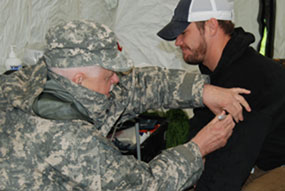Force Health Protection-Investigative New Drugs Participates in Biological incident response exercise

Fort Detrick, Md. –The Force Health Protection-Investigative New Drugs Division of U.S. Army Medical Materiel Development Activity worked with the Maryland Civil Support team and interagency to hold a Biological incident response training exercise April 10.
The training exercise took place at Fort Detrick’s Area B site and included response from USAMMDA FHP-IND, Field Identification of Biological Warfare Agents/United States Army Medical Research Institute of Infectious Diseases staff, 32nd Md. Civil Support team, Fort Detrick Fire, Provost Marshal Office, and the FBI. The use of interagency interactivity for this exercise was required for the conduct, support, and execution of the exercise, as well as to identify the requirements and assign responsibilities.
“The Biological Agent Identification Training site provides a training opportunity with much more depth and complexity than it may appear,” said Richard Arestad, the FIBWA coordinator at USAMRIID. “The BAIT training site was built to provide a venue for first responders to train in a realistic, multi-agency, scenario driven environment.”
This training exercise was designed to test and validate the Emergency Management Plan and determine preparedness in the event of a biological incident.
USAMRIID Diagnostic Systems Division, Field Operations and Training Branch, provided training and oversight of the Civil Support Teams response plan to their current biological incident testing and deployment protocol.
“In providing this venue we hope to give first responders a place to respond to realistic scenarios involving, potentially, the full range of participants that they may encounter in a real incident,” said Arestad, the FIBWA coordinator at USAMRIID. “This provides first responders a chance to realistically interact with other first responder organizations from local law enforcement up to the federal assets previously mentioned.”
In doing this, these teams can resolve any problems that may hinder their effectiveness when responding to a real world incident while assuring their continued proficiency explains Arestad.
“For training purposes, this exercise was time compressed, allowing responders such as FHP-IND time to respond,” said Lt. Col. Max Teehee, FHP director at USAMMDA. “While FHP is not typically a first responder, this exercise allows us, FHP-IND SMRC team, to set up our equipment that would be required to treat patients in a real-world scenario.”
Teehee said that the training also tests the lines of communications with product managers at USAMMDA, the Institutional Review Board at MRMC, the pharmacy, and with USAMMA to get the drugs shipped on short notice.
In this exercise, FHP was responsible for receiving and treating patients that were potentially exposed to inhalational anthrax. First responders took vital signs of the patients and asked questions about their symptoms. The patients were then seen by a doctor onsite to determine which FHP-IND treatment protocol would be used based on the patient’s symptoms. If an IND treatment was advised, the patient would review and sign the consent form to begin treatment. Vital signs were then monitored by medics until the treatment was completed.
“The exercises are vital to testing our response capabilities, and they are key to improving our team's skills, equipment and knowledge to better meet a real world incident,” said Teehee. “The FHP-IND response team takes lessons learned from each exercise to improve our capabilities.”













